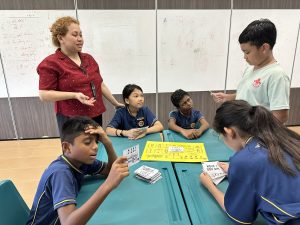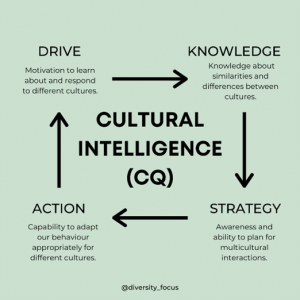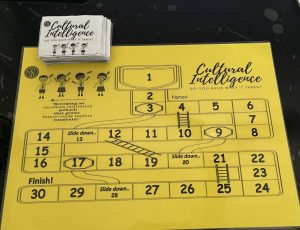Why Singapore’s English Teachers Should Embrace Singlish, Not Fight It
Is it time for Singaporean educators to embrace Singlish as a legitimate learning tool? What the Research […]
Read More
As a multicultural society, Singapore sets the stage for students to experience (school) life with other students from diverse cultures, nationalities and backgrounds. To future-proof and prepare our students to be competent and confident citizens in a globalized world, Cultural Intelligence (CQ) plays an important role in educating and developing them beyond surface-level cultural differences. CQ skills can help one navigate better in any multicultural setting for authentic integration and healthy interaction. In this article, Ms Fadilah Abdul from Wellington Primary School shares how the school adopts the CQ framework by conceptualizing a CQ board game designed as a learn-play intellectual tool for students to appreciate diversity and the importance of harmony.

Cultural Intelligence (CQ) refers to the (cap)ability to relate with people from different backgrounds and work effectively in an environment that is culturally diverse. A relatively new field of research, CQ research was built on growing interest in real world intelligence that focuses on specific content domains such as social intelligence, emotional intelligence and practical intelligence. CQ’s contribution to its research is through its emphasis on the specific domain of intercultural settings, especially in a globalized world.
“At Wellington Primary School (WTPS), we see the value of CQ education as it is necessary and critical to prepare our students to be future-ready when they join the working world, especially in a rapidly globalized world,” shares Ms Fadilah Abdul, Form Teacher for a Primary 4 (P4) class.
Embedding CQ in the Character Citizenship Education (CCE) and Social Studies (SS)syllabus goes beyond the existing notions of cultural sensitivity and awareness on a surface level, as WTPS’students will also learn how to strategically stretch their thinking and understanding to relate and work effectively with people from various backgrounds. “This is to create more authentic integration and healthy interaction, so that they can better navigate and plan effectively in light of cultural differences, as well as to adapt their behaviours accordingly to any scenario,” Fadilah adds.

Figure 1. The CQ Model.
CQ pioneers Professor P. Christopher Earley and Professor Soon Ang described CQ to consist “three aspects, including cognitive, motivational and behavioral elements” (2003), with specific relevance to functioning in a culturally diverse setting.
The model (see Figure 1) consists of four sub-dimensions that contribute to one’s understanding of CQ. Firstly, at the “Knowledge” stage, the cognitive aspect of CQ reflects the mental processes that individuals use to acquire and understand culture-specific knowledge, or control individual thought processes relating to culture.
Next, for “Strategy”, an individual becomes aware and motivated to learn about new cultures. This includes relevant capabilities such as planning, monitoring, and revising their mental models of cultural norms for various groups of people. Fadilah quips, “Those with high metacognitive CQ are consciously aware of other cultural preferences before and during interactions. They also question cultural assumptions and can adjust their mental models during and even after interactions”.
Thirdly, in “Action”, it refers to the capability to exhibit appropriate verbal and nonverbal actions when interacting with people from different cultures. An example would be where an individual possesses a wide and flexible repertoire of behaviors complemented with the cultural understanding to adapt to specific settings.
Finally, “Drive” refers to the capability to direct attention and energy towards learning about and functioning in situations characterized by different cultural differences. Again, those with high motivational CQ can direct their attention and energy towards cross-cultural situations based on their intrinsic interests, as well as their confidence in cross–cultural effectiveness.
“Therefore, ‘Drive’ is critical to facilitate the growth of ‘Knowledge’ and ‘Strategy’. The four dimensions of CQ are qualitatively different aspects of the overall capability to function effectively in a culturally diverse setting and more essentially, CQ is a malleable state-like construct that we can actually develop,” Fadilah explains.
Under the CCE syllabus, there are macro concepts such as diversity and inclusivity which may be difficult for young students to grasp. Fadilah explains that there needs to be a deliberate effort to unpack these concepts and come up with actionable steps for students to learn and not leave it to everyday spontaneous interactions.
The next course of action was to carefully plan conversations and discussions that a teacher can facilitate in the classroom. Through scaffolded discussions, students become more aware of these sensitivities and can understand the factors that shape the identities of people which contribute to Singapore’s diverse society. By developing students’ CQ, it helps them to reflect and examine their experiences with their peers, so that they can appreciate the effects of living in a multicultural society.
“Additionally, by examining societal issues, they are able to demonstrate sound reasoning, responsible decision making, and perspective thinking on a much higher level,” Fadilah adds.
For SS syllabus, some tweaking was required when P4 students were taught on the topic of early settlers. Guiding questions were modified to address how diverse cultures of early settlers form the early social fabric which is part of Singapore’s identity today. Some examples include:
Similar approaches can be used to introduce CQ for Primary 5 (P5) and Primary 6 (P6) students as well.“This is how we can use pockets of social studies lesson to integrate CQ and get students to develop it at the same time as CQ ties in closely given the multicultural situation in Singapore, which allows students to learn how to appreciate living in diversity and develop personal and collective responsibility in maintaining harmony,” Fadilah shares.

Figure 2. The CQ Board Game.
The CQ board game (see Figure 2) was put together by students and they have the ownership to design the game pieces which validates their voices and experiences. Firstly, the “Oh No” cards represent the unpleasant experiences that students may have gone through when CQ was not exercised.
Next, the “RICE” cards were designed after WTPS’ school values and written by the students, as the school wanted to inculcate a deeper understanding on how these values can nurture disposition that will inspire them to show concern and empathy, as well as to encourage perspective thinking while applying CQ in the local context. Finally, “Power” cards were introduced to inject a little bit of fun and competition in the board game.
To facilitate the gameplay, Bloom’s Taxonomy Question Stems was projected on the board to scaffold the different student profiles so that students can be respectful in their questioning and answering techniques without diluting the authenticity of the conversation.
The teacher takes up the essential role as a facilitator as he/she needs to model the approach in using the question stems to ask relevant questions when students are drawing the various card pieces. Naturally, it would be ideal for the grouping to be as diverse as possible to allow more authentic conversations to happen amongst them.
Through the development of the CQ board game, students learnt that their identities are contingent on narratives and that people constantly construct and reconstruct their identities to meet the needs of the situations they encounter. This creates a positive impact and provides better student outcomes in identify formation.
The CQ board game also gave students the freedom to express their likes, dislikes, and opinions, which acknowledges the importance of their voices. A classroom culture of validation was created for the students, which is a critically important experience especially for those who come from disadvantaged backgrounds.
Through these activities, Fadilah believes that it has increased the motivation in future CQ learning in terms of community building. These experiences taught students life skills to work cooperatively among differences in community building. They practice explicit conflict resolution skills when faced with disagreement and work together to reach an agreeable point.
“This develops a sense of community, camaraderie, and shared responsibility when engaging in cross-cultural, appropriate and effective interactions amongst their groups,” Fadilah adds. “Personally, it has been a great learning experience for me as the CQ board game is a compelling way for me to move away from the top-down narrative, and to use case scenarios centered around students’ voices and contestation of ideas based on local context which makes for better internalization of CQ.”
She encourages everyone to keep the conversation going so that collectively, more can be achieved for students to go beyond the level of tolerance and move towards genuine respect and appreciation for diversity.
“Personally, it has been a great learning experience for me as the CQ board game is a compelling way for me to move away from the top-down narrative, and to use case scenarios centered around students’ voices and contestation of ideas based on local context which makes for better internalization of CQ.“
– Fadilah, on her experience in co-creating the CQ board game with her students
Reference
Earley, P. Christopher., & Ang, Soon. (2003). Cultural Intelligence: Individual Interactions Across Cultures. Stanford University Press.